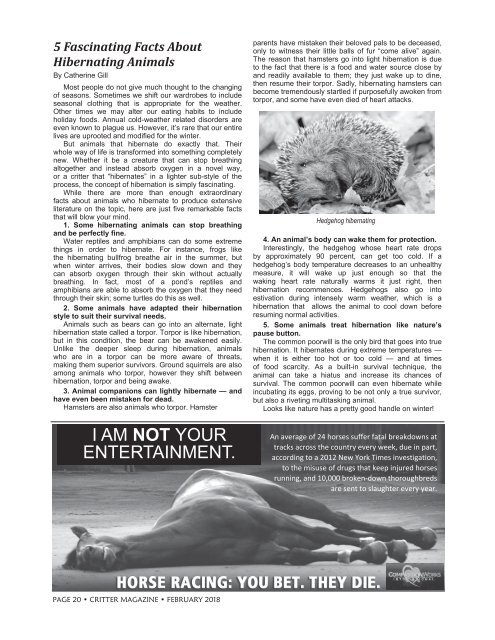You also want an ePaper? Increase the reach of your titles
YUMPU automatically turns print PDFs into web optimized ePapers that Google loves.
5 Fascinating Facts About<br />
Hibernating Animals<br />
By Catherine Gill<br />
Most people do not give much thought to the changing<br />
of seasons. Sometimes we shift our wardrobes to include<br />
seasonal clothing that is appropriate for the weather.<br />
Other times we may alter our eating habits to include<br />
holiday foods. Annual cold-weather related disorders are<br />
even known to plague us. However, it’s rare that our entire<br />
lives are uprooted and modified for the winter.<br />
But animals that hibernate do exactly that. Their<br />
whole way of life is transformed into something completely<br />
new. Whether it be a creature that can stop breathing<br />
altogether and instead absorb oxygen in a novel way,<br />
or a critter that “hibernates” in a lighter sub-style of the<br />
process, the concept of hibernation is simply fascinating.<br />
While there are more than enough extraordinary<br />
facts about animals who hibernate to produce extensive<br />
literature on the topic, here are just five remarkable facts<br />
that will blow your mind.<br />
1. Some hibernating animals can stop breathing<br />
and be perfectly fine.<br />
Water reptiles and amphibians can do some extreme<br />
things in order to hibernate. For instance, frogs like<br />
the hibernating bullfrog breathe air in the summer, but<br />
when winter arrives, their bodies slow down and they<br />
can absorb oxygen through their skin without actually<br />
breathing. In fact, most of a pond’s reptiles and<br />
amphibians are able to absorb the oxygen that they need<br />
through their skin; some turtles do this as well.<br />
2. Some animals have adapted their hibernation<br />
style to suit their survival needs.<br />
Animals such as bears can go into an alternate, light<br />
hibernation state called a torpor. Torpor is like hibernation,<br />
but in this condition, the bear can be awakened easily.<br />
Unlike the deeper sleep during hibernation, animals<br />
who are in a torpor can be more aware of threats,<br />
making them superior survivors. Ground squirrels are also<br />
among animals who torpor, however they shift between<br />
hibernation, torpor and being awake.<br />
3. Animal companions can lightly hibernate — and<br />
have even been mistaken for dead.<br />
Hamsters are also animals who torpor. Hamster<br />
I AM NOT YOUR<br />
ENTERTAINMENT.<br />
parents have mistaken their beloved pals to be deceased,<br />
only to witness their little balls of fur “come alive” again.<br />
The reason that hamsters go into light hibernation is due<br />
to the fact that there is a food and water source close by<br />
and readily available to them; they just wake up to dine,<br />
then resume their torpor. Sadly, hibernating hamsters can<br />
become tremendously startled if purposefully awoken from<br />
torpor, and some have even died of heart attacks.<br />
Hedgehog hibernating<br />
4. An animal’s body can wake them for protection.<br />
Interestingly, the hedgehog whose heart rate drops<br />
by approximately 90 percent, can get too cold. If a<br />
hedgehog’s body temperature decreases to an unhealthy<br />
measure, it will wake up just enough so that the<br />
waking heart rate naturally warms it just right, then<br />
hibernation recommences. Hedgehogs also go into<br />
estivation during intensely warm weather, which is a<br />
hibernation that allows the animal to cool down before<br />
resuming normal activities.<br />
5. Some animals treat hibernation like nature’s<br />
pause button.<br />
The common poorwill is the only bird that goes into true<br />
hibernation. It hibernates during extreme temperatures —<br />
when it is either too hot or too cold — and at times<br />
of food scarcity. As a built-in survival technique, the<br />
animal can take a hiatus and increase its chances of<br />
survival. The common poorwill can even hibernate while<br />
incubating its eggs, proving to be not only a true survivor,<br />
but also a riveting multitasking animal.<br />
Looks like nature has a pretty good handle on winter!<br />
An average of 24 horses suffer fatal breakdowns at<br />
tracks across the country every week, due in part,<br />
according to a 2012 New York Times investigation,<br />
to the misuse of drugs that keep injured horses<br />
running, and 10,000 broken-down thoroughbreds<br />
are sent to slaughter every year.<br />
PAGE 16 • CRITTER MAGAZINE • NOVEMBER 2017<br />
PAGE 20 • CRITTER MAGAZINE • FEBRUARY <strong>2018</strong>

















